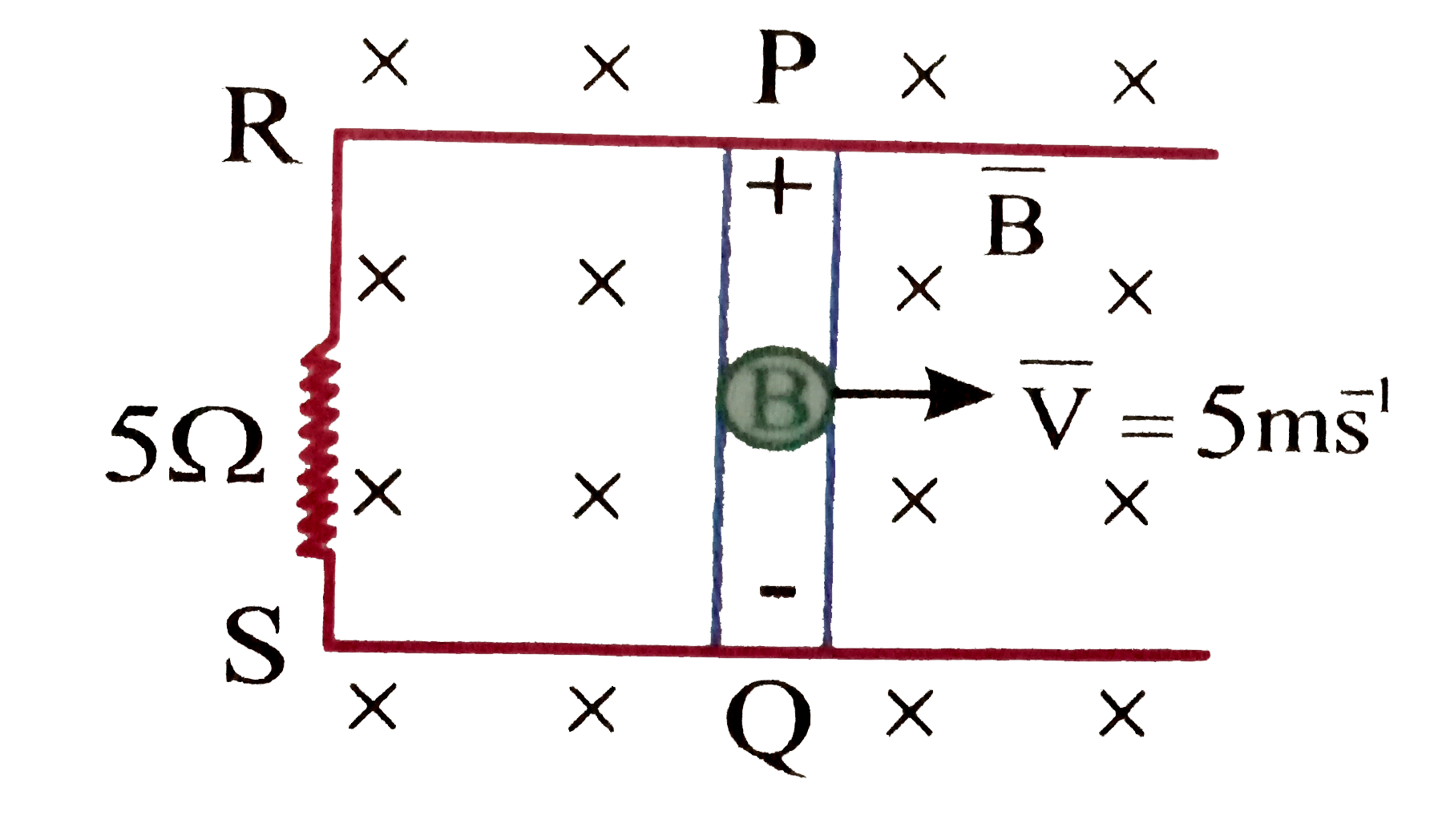A conducting rod PQ of length L=1.0m is moving with a uniform speed v=2.0ms−1 in a uniform magnetic field B=4.0T directed into the plane of the paper.
A capacitor of capacity C=10μF is connected as shown in , then

(a) qA=+80μCandqB−80μC
(b) qA=−80μCandqB+80μC
( c) qA=0=qB
(d) charge stored in the capacitor increases exponentially with time
The correct Answer is:A
( a) q=CV=C(Bvl)
=(10×10−6)(4)(2)(1)
=80μC=constant
Magnetic force on the electron in the counducting rod PQ is towards Q. Therefore, A is positively charged and B is negatively charged.

Topper's Solved these Questions
- ELECTROMAGNETIC INDUCTIONBOOK - CENGAGE PHYSICSCHAPTER - ELECTROMAGNETIC INDUCTIONEXERCISE - Exercises Multiple Correct
23 Videos
- ELECTROMAGNETIC INDUCTIONBOOK - CENGAGE PHYSICSCHAPTER - ELECTROMAGNETIC INDUCTIONEXERCISE - Exercises Asserton - Reasoning
8 Videos
- ELECTROMAGNETIC INDUCTIONBOOK - CENGAGE PHYSICSCHAPTER - ELECTROMAGNETIC INDUCTIONEXERCISE - Exercises Subjective
13 Videos
- ELECTROMAGENTIC INDUCTIONBOOK - CENGAGE PHYSICSCHAPTER - ELECTROMAGENTIC INDUCTIONEXERCISE - QUESTION BANK
40 Videos
- ELECTRON,PHONTS,PHOTOELECTRIC EFFECT & X-RAYSBOOK - CENGAGE PHYSICSCHAPTER - ELECTRON,PHONTS,PHOTOELECTRIC EFFECT & X-RAYSEXERCISE - dpp 3.3
15 Videos
Similar Questions
A conducting rod AC of length 4l is rotated about point O in a uniform magnetic field →B directed into the plane of the paper. AO=landOC=3l. Find VA−VC.

View SolutionA conductor or length 0.1m is moving with a velocity of 4m/s in a uniform magnetic field of 2T as shwon in the figure. Find the emf induced?

View Solution
Knowledge Check
A conducting rod PQ of length l=1.0m is moving with a uniform speed v2.0m/s in a uniform magnetic field B=4.0T directed into the paper.
A capacitor of capacity C=10μF is connected as shown in figure. Then
 AqA=+80μCandqB=−80μCBqA=−80μCandqB=+80μCCqA=0=qBDCharge stored in the capacitor increase exponentially with time
AqA=+80μCandqB=−80μCBqA=−80μCandqB=+80μCCqA=0=qBDCharge stored in the capacitor increase exponentially with timeA conducting rod PQ of length 1m is moving with uniform velocity of 2m/s in a uniform magnetic field of 2T directed inot the plane of paper. A capacitor of capacity c=10μF is connected as shown. Then :
 AqA=+40μC,qB=+40μCBqA=+40μC,qB=−40μCCqA=−40μC,qB=+40μCDqA=qB=0
AqA=+40μC,qB=+40μCBqA=+40μC,qB=−40μCCqA=−40μC,qB=+40μCDqA=qB=0A conducting rod of length L=0.1m is moving with a uniform sped v=0.2m/s on conducting raisli a magnetic field B=0.5T as shown. On one side, the end of the rails is connected to a capacitor of capacitance C=20μF. Then, the charge on the capacitor's plates are
 AqA=0=qBBqA=+20μCandqB=−20μCCqA=+0.2μCandqB=−0.2μCDqA=−0.2CandqB=−0.2μC
AqA=0=qBBqA=+20μCandqB=−20μCCqA=+0.2μCandqB=−0.2μCDqA=−0.2CandqB=−0.2μC
a conducting rod of length L=30.0cm movies in a magnetic field →B of magnitude 0.450T directed into the plane of the figure. The rod moves with speed v=5.00ms−1 in the direction shown.

(a) What is motional emf inuced in the rod ?
(b) What is the potential difference between the ends of the rod?
( c) When point, aorb, is at higher potential?
(d) When the charges in the rod are in equilibrium, what are the magnitude and direction of the electric field within the rod?
(e) When the charges in the rod are in the rod in equilibrium, which point, aorb, has an excess of positive charge?
View SolutionFigure shows a conducting rod PQ in contact with metal rails RP and SQ, which are 0.25m apart in a uniform magnetic field of flux density 0.4T acting perpendicular to the plane of the paper. Ends R and S are connected through a 5Ω resistance. What is the emf when the rod moves to the right with a velocity of 5ms−1 ? What is the magnitude and direction of the current through the 5Ω resistance? If the rod PQ moves to the left with the same speed, what will be the new current and its direction?

View SolutionA small conducting rod of length l, moves with a uniform velocity v in a uniform magnetic field B as shown in fig __

View SolutionA conducting rod PQ of length l=2m is moving at a speed of 2ms−1 making an angle of 30∘ with its length. A uniform magnetic field B=2T exists in a direction perpendicular to the plane of motin. Then

View SolutionA conducitng rod AB of length l=1m moving at a velcity v=4m/s making an angle 30∘ with its length. A uniform magnetic field B=2T exists in a direction perpendicular to the plane of motion. Then :

View Solution
